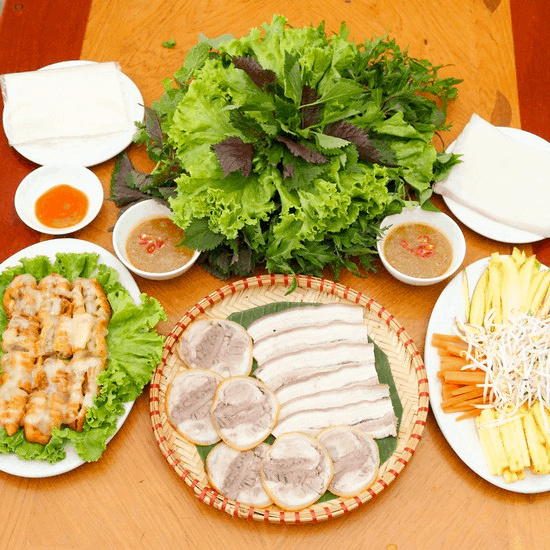In addition to Quang noodles, Cao Lau, when coming to Quang Nam, visitors must not miss the unique and sophisticated pork rice paper originating here. If you want to be flexible, chewy and delicious, you must choose genuine Dai Loc rice paper. Rice paper consists of 2 types: dry rice paper and water rice paper. Dry rice paper, also known as rice paper margin, has a moderate toughness used to roll, not as thin as the rice paper rolls of the North nor too thick like some other localities. Wet rice paper is rice paper that is finished to be used during the day, not dried. Pork here is pork belly or meat with fat on both ends. Next, it is impossible not to mention raw vegetables to roll with. If the raw vegetables eaten were from Tra Que vegetable village in Hoi An, it would be wonderful. Selected raw vegetables are broccoli, lettuce, basil, lettuce, scallions, herbs, bitter vegetables, bean sprouts, cucumber, acrid banana… belongs to the fresh and young type and is indispensable for sharp, thin bananas and split water spinach. And finally, the indispensable thing that contributes to the flavor when eating is a slow bowl of Quang-style slow water. Especially, you should add green chili to the bowl of dipping sauce, then enjoy it with a bowl of fragrant fish sauce and still have a bright yellow color.

Photo: Collectibles
The unique pork rice paper, rich in Quang flavor, has retained many flavors with visitors. This delicious and famous dish has spread all over the world. You can find many pork roll rice paper shops in Hanoi and Ho Chi Minh City to enjoy if you don’t have the opportunity to come to Hoi An.
Source: Collected internet.
The North and North Central regions have a humid subtropical climate with 4 seasons: Spring, Summer, Autumn, and Winter. The Central and South Central regions have a tropical monsoon climate, the extreme South Central and Southern regions have tropical savanna characteristics. At the same time, it is directly influenced by the trade monsoon climate, which often blows in low latitudes. The South often has a tropical savanna climate, hot and humid with two seasons: dry season and rainy season (from April-May to October-November). Every year, the cold and humid winter typical of the North contrasts with the warm atmosphere of Tet and spring in the South.
Vietnam has an area of 331,690 km², located in the east of the Indochina peninsula, in Southeast Asia. Sharing a border with three countries, Vietnam borders China to the north, Laos and Cambodia to the west, and the East Sea to the east. In 2019, Vietnam's population was more than 96 million people, ranking 13th in the world. Hanoi, the capital of Vietnam, is the second largest city with 6.2 million people, after Ho Chi Minh City, 8.8 million people.
Vietnam's history began from 1 to 2 thousand years BC. Over many centuries with the Ly, Tran, Le, and Nguyen dynasties, from the mid-19th century, Vietnam became a French colony. After the August Revolution, the Democratic Republic of Vietnam was born. The Battle of Dien Bien Phu in 1954 marked the end of the French in the territory, but Vietnam was divided into two countries: the Democratic Republic of Vietnam in the North and the Republic of Vietnam in the South. After the events of April 30, 1975, Vietnam was unified and from July 2, 1976, officially named the Socialist Republic of Vietnam.
Religion in Vietnam is quite diverse, including Buddhism (both Mahayana, Theravada and some modified groups such as Hoa Hao, Tu An Hieu Nghia); Christianity (including Catholicism and Protestantism); endogenous religions such as Cao Dai; and some other religions (Hinduism and Islam). Different types of folk beliefs also have a lot of influence. The majority of Vietnamese people consider themselves non-religious, even though they still go to religious sites several times a year...